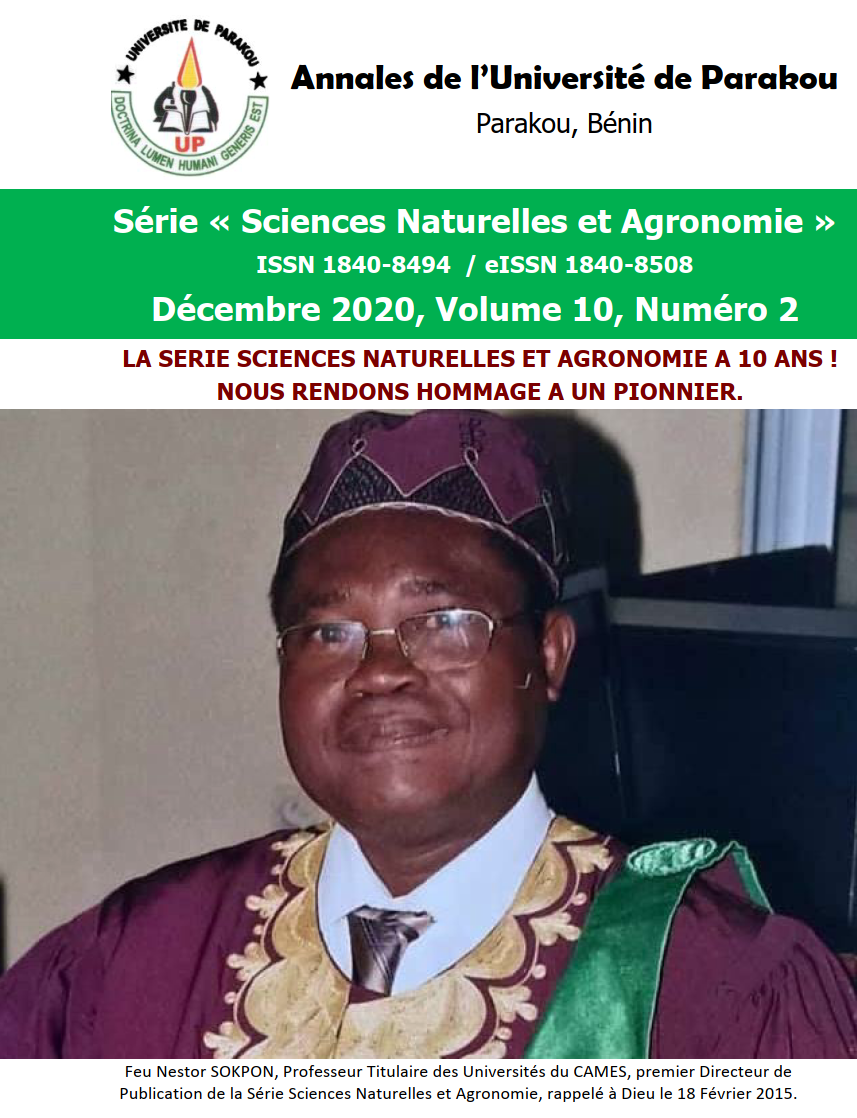Diversity and distribution of sweet potato weevils (Cylas spp.) in southern Benin
DOI :
https://doi.org/10.56109/aup-sna.v9i1.58Mots-clés :
Sweet potato, Cylas puncticollis, Cylas brunneus, identification, distribution, incidence, BeninRésumé
Sweet potato (SP) weevils, Cylas spp. are important pests of SP throughout the world and particularly in Africa. They cause damage to the crop as a result of their diet and reproduction. This study was undertaken to identify species of Cylas attached to SP production in southern Benin and to assess the distribution of the insects in study areas. A survey was conducted from October to December 2015 in fifteen districts of the departments of Mono, Couffo, Ouémé and Plateau in agro-ecological zones 6, 7 and 8 of Southern Benin. Weevil adults were collected alone in bulk but also along with infested vines and tuberous roots. Sweet potato vines and tuberous roots were incubated in laboratory for emergency of insect adults. Two species of Cylas were identified: C. puncticollis Boheman and C. brunneus Schoenherr. Cylas puncticollis were observed in 82.70% of total samples collected and were found in all districts prospected while C. brunneus were observed in 17.42% of the samples and were observed only in the districts of Adjohoun, Bopa, Houéyogbé, Ifangni and Klouékanmè. The highest incidence (100.00 ± 0.00%) and the lowest incidence (0.00 ± 0.00%) were recorded with C. puncticollis and C. brunneus, respectively, in the districts of Aplahoué, Comè, Sakété, Adja-Ouèrè and Toviklin. All SP farmers used only vine cuttings for planting, with 10% of them treating planting material with chemical insecticides. Eighty percent of farmers use planting materials taken in their own fields whereas 20% obtain them from neighboring fields either free of charge or purchase them. This study gave use more detailed information on the identity and distribution of sweet potato weevils in Benin and was useful for the establishment of control measures against them.
Téléchargements
Métriques
Références
Adom M.Wilsona D.D. Feninga O.K. Bruced A.Y. & Adofo K. 2018. Bionomics of the sweet potato weevil, Cylas puncticollis (Coleoptera: Brentidae) on four different sweet potato varieties in sub-Saharan Africa. J. Agr. Rural Dev. Trop., 119 (1): 55–63.
Anyanga M.O. Muyinza H. Talwana H. Hall D.R. Farman D.I. Ssemakula G.N. et al. 2013. Resistance to the weevils Cylas puncticollis and Cylas brunneus conferred by sweet potato root surface compounds. J.Agricult. Food Chem., 61: 8141–8147. DOI: https://doi.org/10.1021/jf4024992
Baimey H. Fanou A. Adandonon A. Behoundja-Kotoko O. Agandan N. Houssou G. et al. 2017. Sweet potato Ipomoea batatas (L.) storage practices used in southern Benin and the use of entomopathogenic nematodes to control sweet potato weevil (Cylas puncticollis Boheman) under laboratory conditions. J. Entomol Zool. Stud., 5(6):549-556.
Bhattarai P. 2015. Sweet Potato Research for Enhancing Food and Nutrition Security in Nepal. Journal of Horticulture, Forestry and Biotechnology, 19(4): 62-70.
CAB International 2005. Distribution maps of plant pests. 1st revision A: Map No. 279. Cylas puncticollis (Boheman). International Institute of Entomology, London.
Capinera J.L. 2001. Handbook of Vegetable Pests. Academic Press, San Diego, Calif, USA.
CIP 2013. Everything you ever wanted to know about Sweet potato. Reaching Agents of Change ToT training manual. Topic 6: Sweet potato Production and Management and Topic 7: Sweet potato Pest and Disease Management. International Potato Center-Sub-Saharan Africa Regional Office (SSA). Nairobi, Kenya, 74p. DOI: 10.4160/9789290604273.
Damalas C.A. & Eleftherohorinos I. G. 2011. Pesticide exposure, safety issues and risk assessment indicators. Int. J. Environ. Res. Public Health, 8: 1402-1419.doi:10.3390/ijerph8051402. DOI: https://doi.org/10.3390/ijerph8051402
Dhaliwal M.S. 2017. Tuber vegetable crops: 311- 352. In: Dhaliwal M. S. (ed.), Handbook of Vegetable Crops. Edition: 3rd, Chapter 12, Kalyani Publishers.
Djinet A.I. Nana R. Nguinambaye M.M. Badiel B. Konate B., Nanema L. & Tamini Z. 2016. Etude du comportement de dix (10) variétés de patate douce cultivées à Bongor en saison sèche. Int. J. Innov. Appl. Stud., 17(4): 1384-1390.
Doussoh A.M. Dangou J.S. Houedjissin S.S. Assogba A. K. & Ahanhanzo Glele C. 2016. Analyse des connaissances endogènes et des déterminants de la production de la patate douce [Ipomoea batatas (L.)], une culture à haute valeur socioculturelle et économique au Bénin. Int. J. Biol. Chem. Sci., 10(6): 2596-2616. http://dx.doi.org/10.4314/ijbcs.v10i6.16. DOI: https://doi.org/10.4314/ijbcs.v10i6.16
Ehisianya C.N. Lale N.E.S. Umeozor C.O. Amadi C.O. & Zakka U. 2011. Evaluation of the effectiveness of variety, tillage method and time of harvest on sweet potato yield and the population of sweet potato weevil, Cylas puncticollis (Boheman) (Coleoptera: Brentidae). International Journal of Advanced Scientific and Technical Research, 1(2): 165-183.
ELzubeir A. EL-Khidir EL-I. & Mowafi K. 2018. Developmental Stages of African Sweet potato Weevil Cylas puncticollis Boheman (Coleoptera: Brentidae) in Sudan. Asian Res. J. Agric., 10(2): 1-6. DOI: https://doi.org/10.9734/ARJA/2018/45767
FAOSTAT 2015. Food and Agriculture Organization of the United Nations Statistical Databases.http://faostat3.fao.org/browse/Q/QC/E.
Fuglie K.O. 2007. Priorities for sweetpotato research in developing Countries: Results of a survey. HortScience, 42: 1200-1206.https://doi.org/10.21273/HORTSCI.42.5.1200 DOI: https://doi.org/10.21273/HORTSCI.42.5.1200
Hue S.-M. & Low M.-Y. 2015. An Insight into Sweet Potato Weevils Management: A Review. Review Article, 11 p. http://dx.doi.org/10.1155/2015/849560. DOI: https://doi.org/10.1155/2015/849560
Korada R.R. Naskar S.K. Palaniswami M.S.& Ray R.C. 2010. Management of Sweet potato weevil [Cylas formicarius (Fab.)]: An Overview. Indian Society for Root Crops. J. Root Crops, 36 (1): 14-26.
Magira P. 2003. Evaluating sweet potato clones for resistance to the African sweet potato weevils (Cylas puncticollis) Boheman and Cylas brunneus (Fab.) (Coleoptera: Apionidae). MSc thesis, Makerere University, pp: 26-30.
Mansaray A. Sundufu A.J. Moseray M.T. & Fomba S.N. 2015. Sweet potato Weevil (Cylas puncticollis) Boheman Infestation: Cultivar Differences and the Effects of Mulching. The Open Entomology Journal, 9 : 7-11. DOI: 10.9734/ARJA/2018/45767 DOI: https://doi.org/10.2174/1874407901509010007
Musana P. Okonya J. S. Mujica N. Carhuapoma P. & Kroschel J. 2016. Sweetpotato weevil, Cylas brunneus (Fabricius):64-73. In: Kroschel J. Mujica N. Carhuapoma P.& Sporleder M. (Eds.), Pest distribution and risk atlas for Africa. Potential global and regional distribution and abundance of agricultural and horticultural pests and associated biocontrol agents under current and future climates. Lima, Peru. International Potato Center (CIP). DOI: 10.4160/97892906047615.
Ministère de l’Agriculture, de l’Elevage et de la Pêche (MAEP) 2016. Résultats définitifs de la campagne agricole: 2015-2016. Direction de la statistique agricole. Cotonou, Bénin, MAEP.
Muyinza H. Talwana H. T. Herbert L. Mwamga R.O.M.& Stevenson P.C. 2012. Sweet potato weevil (Cylas spp.) resistance in African sweet potato germplasm. Int. J. Pest.Manage.,58(1): 73-81.https://doi.org/10.1080/09670874.2012.655701. DOI: https://doi.org/10.1080/09670874.2012.655701
Mvumi C. Zendera B.& Mashayamombe B. 2018. Vine harvesting frequency impact on tuber yield attributes of commonest sweet potato cultivar in Sub-Saharan Africa. Int. J. Agron. Agri. R., 12(6): 30-38.
Mwanga R.O.M. Odongo B. Niringiye C. Alajo A. Kigozi B. Makumbi R. et al. 2009. ‘NASPOT 7’, ‘NASPOT 8’, ‘NASPOT 9 O’, ‘NASPOT 10 O’, and ‘Dimbuka Bukulula’ Sweet potato. Hortscience, 44(3): 828–832. DOI: https://doi.org/10.21273/HORTSCI.44.3.828
Nderitu J. Silai M. Nyamasyo G. & Kasina M. 2009. Insect species associated with sweet potatoes (Ipomoea batatas (L.) Lam) in Eastern Kenya. Int. J. Sustain. Crop Prod., 4(1):14-18.
Okonya J.S. Mujica N. Carhuapoma P. & Kroschel J. 2016. Sweet potato weevil, Cylas puncticollis (Boheman 1883): 54-63. In Kroschel J.Mujica N. Carhuapoma P. & Sporleder M. (Eds.), Potential global and regional distribution and abundance of agricultural and horticultural pests and associated biocontrol agents under current and future climates. CIP: Pest distribution and risk atlas for Africa, Lima, Peru.
Okonya J.S. Mwanga O.M. Syndicus R.K. & Kroschel J. 2014. Insect pests of sweet potato in Uganda: farmers’perceptions of their importance and control practices. SpringerPlus, 3(1): 303. doi: 10.1186/2193-1801-3-303. DOI: https://doi.org/10.1186/2193-1801-3-303
Programme d’Action National d’Adaptation aux changements climatiques du Bénin (PANA-Bénin) 2007. Convention-Cadre des Nations Unies sur les changements climatiques. Cotonou, 81p.
Rukarwa R.J. 2014. Transgenic breeding of sweetpotato for resistance to African Weevil (Cylas puncticollis). Doctoral dissertation, Makerere University, Uganda, 123p.
Smit N.E.J. M. & van Huis, A. 1998. Biology of the African sweet potato weevil species Cylas puncticollis (Boheman) and C. brunneus (Fabricius) (Coleoptera: Apionidae). Int. J. Trop. Insect Sci., 18(2): 93-100. DOI: https://doi.org/10.1017/S1742758400007712
Stathers T. Carey E. Mwanga R. Njoku J. Malinga J. Njoku A. et al. 2013. Tout ce que vous avez toujours voulu savoir à propos de la patate douce : Atteindre les agents du changement, manuel de formation des formateur (FdF) 4: Production et gestion de la patate douce; Gestion des ravageurs et des maladies de la patate douce. Centre International de la Pomme de Terre, Nairobi, Kenya, 4p.
Stathers T.E. Rees D. Kabi S. Mbilinyi L. Smith N. Kiozya H. et al. 2003. Sweet potato infestation by Cylas spp. in East Africa: I. Cultivar differences in field infestation and the role of plant factors. Int. J. Pest Manage., 49:131–140. DOI: https://doi.org/10.1080/0967087021000043085
Stevenson P.C. Muyinza H. Hall D.R. Porter E.A. Farman D.I. TalwanaH. & Mwanga R.O. M. 2009. Chemical basis for resistance in sweet potato Ipomoea batatas to the sweet potato weevil Cylas puncticollis..Pure and Applied Chemistry, 81(1): 141–151. DOI: https://doi.org/10.1351/PAC-CON-08-02-10
Tang S. & Cheke A.R. 2008. Models for integrated pest control and their biological implications. Mathematical Biosciences, 215: 115–125. DOI: https://doi.org/10.1016/j.mbs.2008.06.008
Tanzubil P.B. 2015. Insect pests of sweet potato in the Sudan savannah zone of Ghana. J. Entomol. Zool. Stud., 3(2): 124-126.
Tewe O.O. Ojeniyi F.E. & Abu O.A. 2003. Sweet potato production, utilization, and marketing in Nigeria. International Potato Center (CIP), Lima, Peru, 44p.
Van Lenteren J.C. 2000. Measures of success in biological control of arthropods by augmentation of natural enemies: 77-103. In: Wratten S. & Gurr G. (Eds.), Measures of Success in Biological Control, Kluwer, Dordrecht. DOI: https://doi.org/10.1007/978-94-011-4014-0_3
Varin D. Blanc S. & Brevar. J. 2009. La culture de la patate douce en Nouvelle-Calédonie. Association Inter-provinciale de gestion des Centres Agricoles. Centre des Tubercules Tropicaux, AICA, 27p.
Wolfe G.W. 1991. The origin and dispersal of the pest species of Cylas with a Key to the pest species groups of the world: 13-44. In: Jansson R.K. & Raman K.V. (Eds.), Sweet potato Pest Management. A Global Perspective. West view Press, Boulder, Colorado, USA. DOI: https://doi.org/10.1201/9780429308109-2
Zinsou V. Paraïso A. Thomas-Odjo A. & Ahohuendo B. C. 2010. Identification des principaux agents pathogènes de la patate douce (Ipomoea batatas Lam) au Nord-Bénin. Annales des Sciences Agronomiques, 14(2) : 241-255. DOI: https://doi.org/10.4314/asab.v14i2.67362














